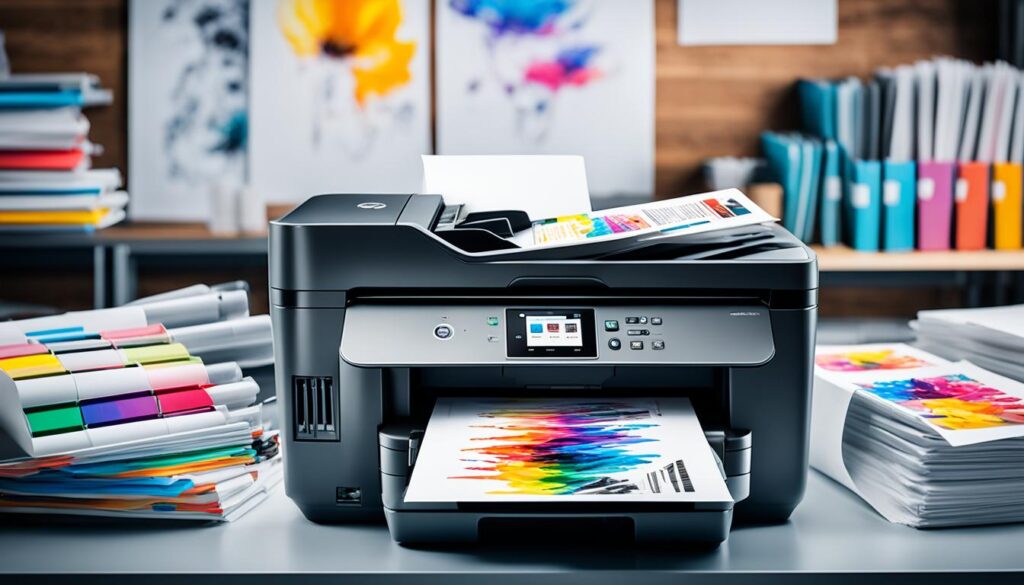In this guide, I’ll show you how to create top-notch art prints from your original art. This is a great skill for artists at any level. It can help you share and sell your work more easily. We’ll cover everything from printing methods to materials and finding the best printing service. So, get ready to start making your own art prints.
Key Takeaways
- Understand the art printing process and different techniques
- Prepare your artwork for high-quality printing
- Choose the right paper and printing method for your art
- Find a reputable art printing company to produce your prints
- Learn how to properly sign and number your art prints
Understanding the Art Printing Process
Understanding the art printing world before you begin is key. There are many types of art prints and printing methods out there. You’ll encounter anything from giclee prints known for quality to screen prints full of color. The method matters, too, whether it’s inkjet printing, offset printing, or digital printing.
Types of Art Prints
- Giclee Prints: Made with inkjet tech, giclee prints shine with detail, colors, and durability.
- Screen Prints: Printed by hand, screen prints are vibrant, bold creations.
- Digital Prints: Digital prints use modern printers for a flexible and cost-friendly option.
Different Printing Techniques
Choosing the right printing method is crucial for your art prints‘ look. Let’s look at the top methods:
- Inkjet Printing: Uses liquid inks to produce detailed, colorful art prints.
- Offset Printing: A method for high-quality, uniform art prints through ink transfer.
- Digital Printing: This method prints digital files directly, efficiently and cost effectively.
Learning about art prints and printing helps you choose the right path. By looking at these options, you can realize your artistic dreams.
Preparing Your Artwork for Printing
The first step to getting great art prints is preparing your artwork right. If your art is already in a digital format, you can skip this section. If not, you’ll need to scan or take a high-quality photo of it. This step is important for making sure your printed art looks amazing.
Scanning or Photographing Your Artwork
If you have a painting or a drawing, you need to turn it into a digital file. Use a good scanner or camera for this. Aim for the best resolution to capture all details.
When using a camera, set up good lighting and take clear, focused photos. It’s essential to keep all details visible and sharp.
Whether you scan or photo, save as TIFF or PNG to keep the quality high.
“Proper preparation of your artwork is the key to creating stunning art prints that truly capture the essence of your original work.”
Editing and Enhancing the Digital File
After getting a digital file, you might need to edit it. Tools like adjusting colors, brightness, and removing blemishes can make your art look its best.
Don’t know how to edit images? Online services can help. They make sure your file is ready for printing.
Color management is vital for accurate print colors. Calibrate your monitor and use color-friendly software. Also, working with your printer helps get the colors right.

Deciding on the print size is also crucial. Think about where it will be displayed and its impact. Paying attention to these details ensures your art prints are stunning and true to your vision.
Follow these steps and use the best art printing tech. This way, you can turn your art into quality print on demand art prints. Then, share your art proudly.
Choosing the Right Paper and Printing Method
Creating top-notch art prints depends heavily on the paper and printing method you pick. For artists, knowing the best paper and print types is key. It helps achieve the perfect look and feel for your art.
Paper Options for Art Prints
The paper type you use can largely influence your art prints’ quality and look. Let’s look at some popular paper choices:
- Fine Art Papers: They’re made for inkjet printing and come in different textures and finishes like matte or glossy. Ideal for showing off details in your art.
- Archival Papers: These papers prevent fading and discoloration, making them great for long-lasting or limited-edition prints. They are usually very smooth.
- Specialty Papers: You might want to use materials like watercolor paper or metallic paper for a special touch. This adds unique visuals and feels to your prints.
“Choosing the right paper is crucial for creating art prints that truly capture the essence of your artwork and stand the test of time.”
When picking paper, think about the type of art you do, the finish you want, and how long the prints need to last. Getting advice from printing professionals can also guide you to the best choice.
Professional Art Printing Services
For artists, creating high-quality prints of their work is crucial. Yet, many lack the tools or know-how. Trusting a top art printing service is key for perfect prints.
Looking for an art printing partner? Find one with a diverse selection, offering everything from limited to open edition prints. Good art printing websites will clearly show what they can do.
Quality should never be compromised in fine art printing. Make sure your chosen best art printer uses the finest materials, like top-notch inks and papers. This ensures your prints stay vivid for years. Reading about others’ experiences with the service can tell you a lot too.
Great customer service is vital in the printing world. The right service will not only print your work but help you understand the process. They can advise you on how to print digital art and help choose between a poster vs art print.
Selecting the right artist prints on demand provider is key. It means your prints will meet the highest standards and truly show your art’s beauty.
Signing and Numbering Your Art Prints
Being an artist, it’s vital to sign and number your prints correctly. This step gives your prints value and keeps them exclusive. It also helps manage your inventory and track editions. I will show you how to sign and number your art prints. I’ll also give tips on choosing edition sizes and handling artist proofs.
Signing Your Art Prints
Signing your art prints is key to proving their authenticity. There are several ways you can do this:
- Hand-sign each print with a top-notch archival pen or pencil. This makes every print one-of-a-kind.
- Use a printed or stamped signature. It keeps your edition uniform but still adds a personal mark.
- Add your digital or printed signature to the image before printing. This is easy, but it’s not as personal as a hand signature.
Whichever way you choose, always place your signature in the same spot on every print, like the bottom right corner or on the back.
Numbering Your Art Prints
Numbering your prints is crucial for marking them as part of a limited edition. This shows buyers the prints’ scarcity and exclusiveness. When numbering, follow these important tips:
- First, decide how many prints will be in the edition.
- Number your prints as “X/Y,” with “X” being the print’s number and “Y” as the edition’s total size. For instance, “12/50” means it’s the 12th print in a series of 50.
- Add the print number to the bottom margin or on the back of the print.
- Always keep detailed records of your editions.
Proper signing and numbering can enhance your art’s appeal and value to both collectors and buyers.
“The signature is the artist’s mark of ownership, authenticity, and quality. It’s the final touch that transforms a print into a work of art.”
Conclusion
We’ve looked at how to make top-notch art prints from your own art. This guide gives you what you need to start printing your work. I hope you found it helpful for your art journey.
Making art prints is all about trying new things and getting better. Try what you’ve learned and don’t be afraid to talk about your art print stories. Reach out to local art print companies and think about selling your prints in different places.
If you’re searching for art printers near me or where to get art prints made canada, this guide helps you understand art printing and selling your prints. Enjoy the learning process and let your creativity show.

